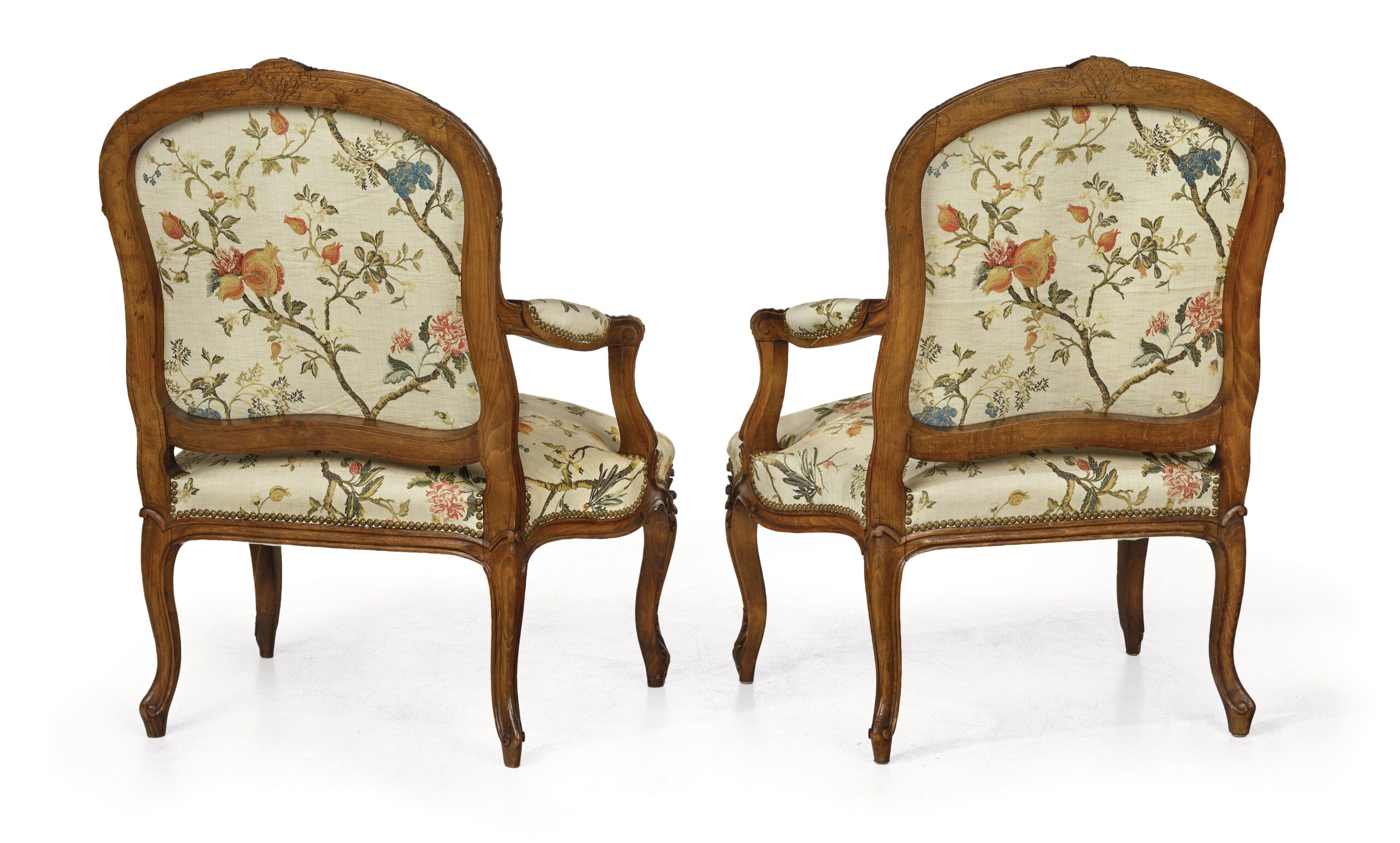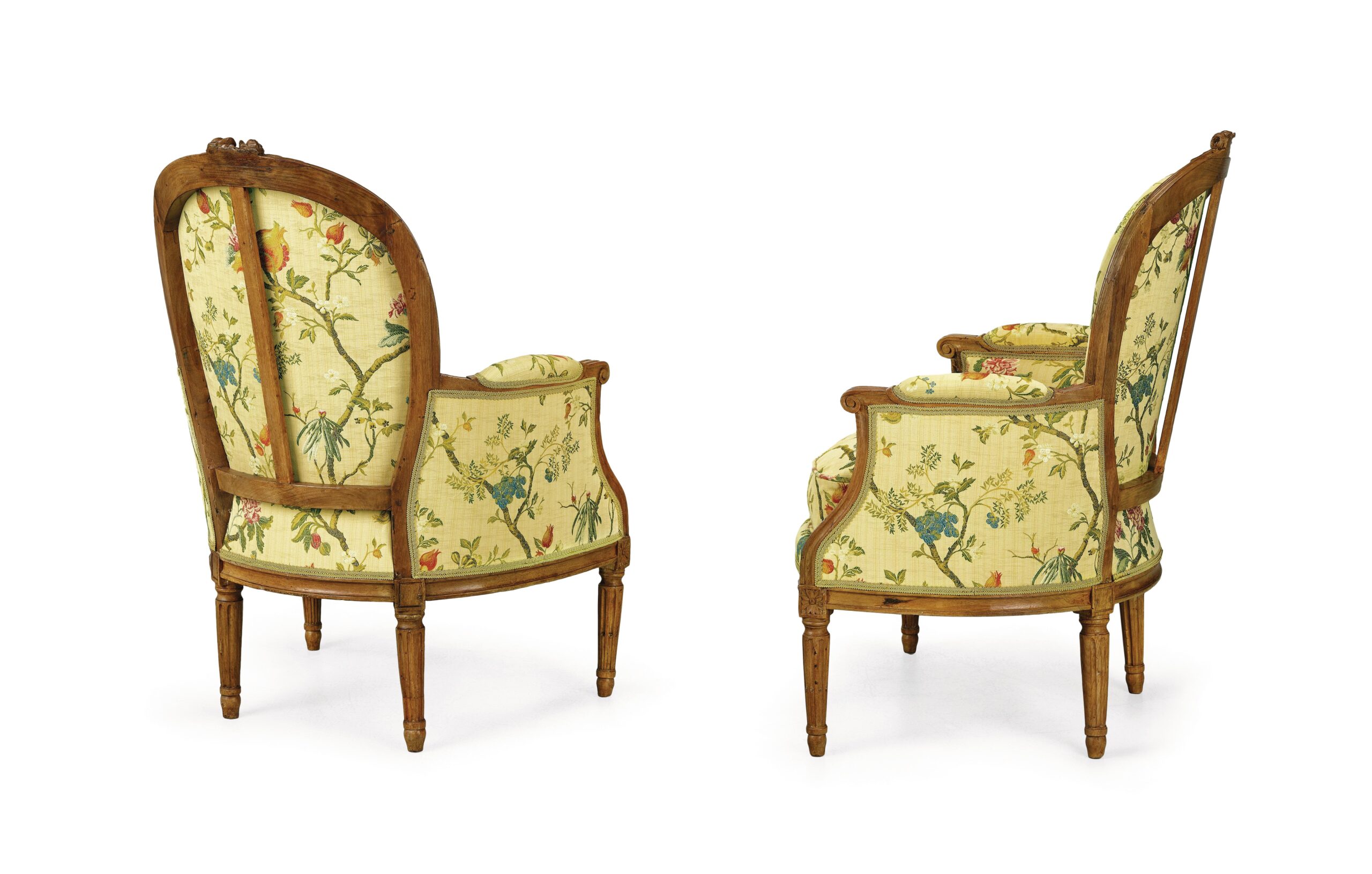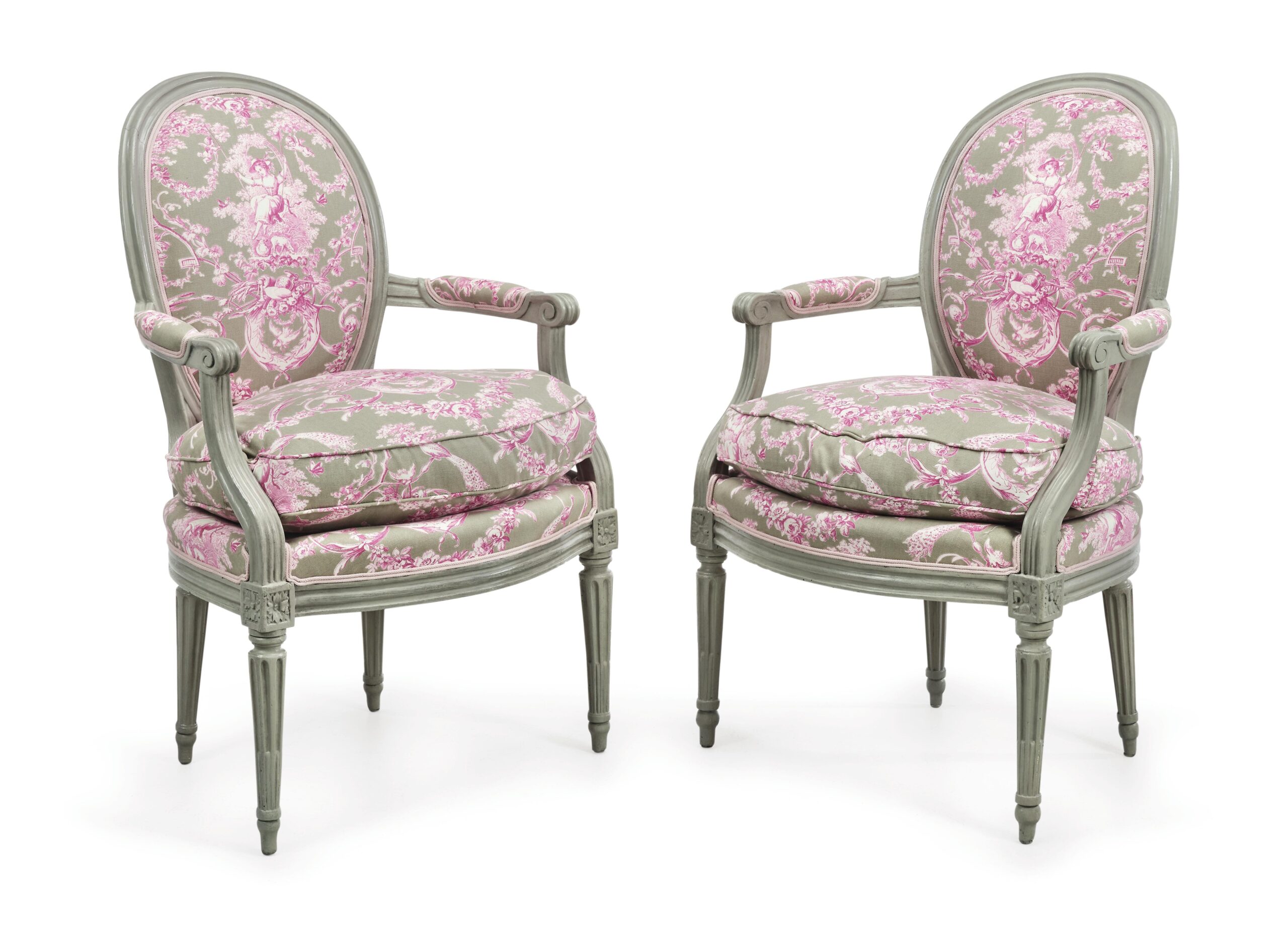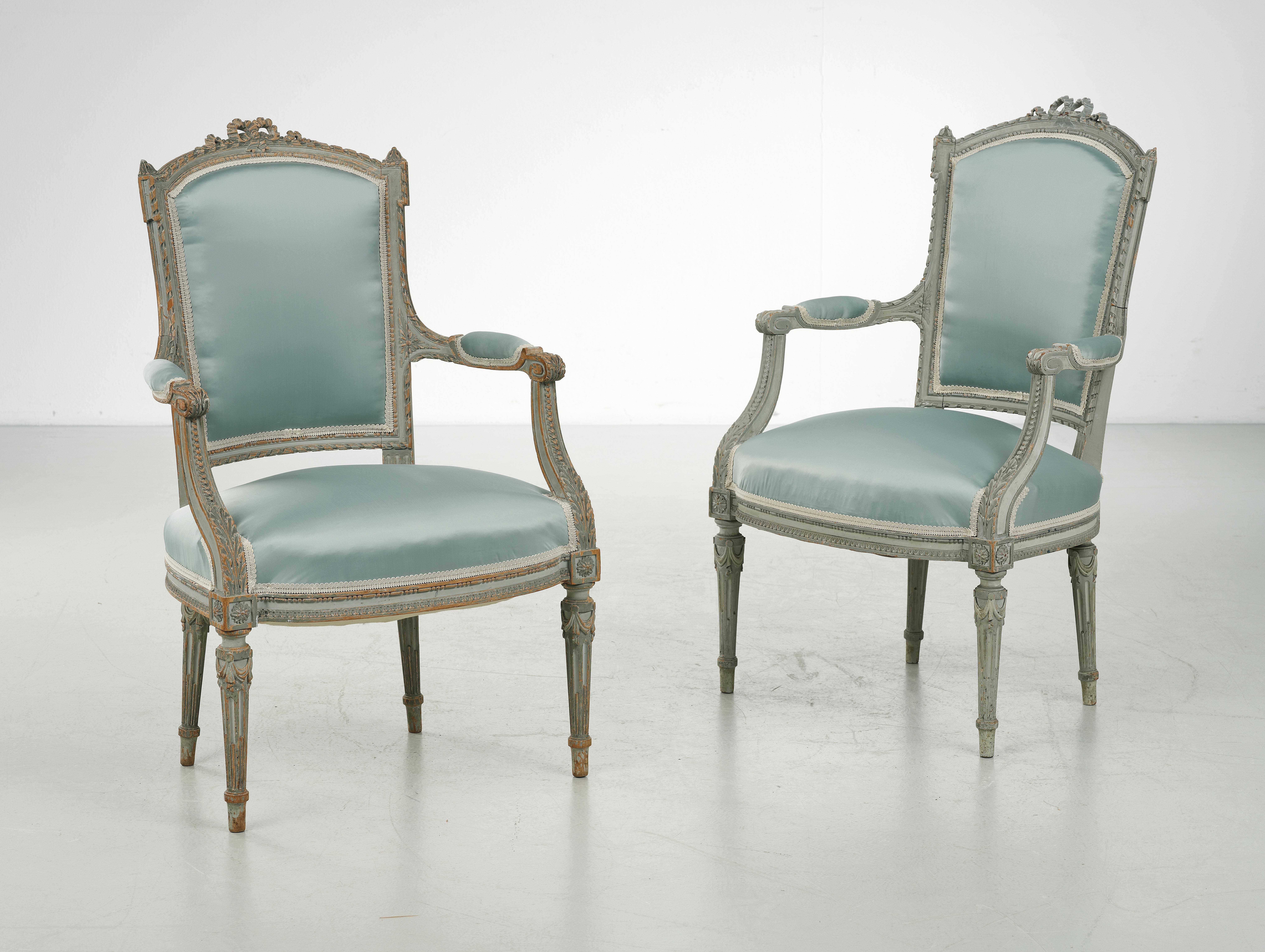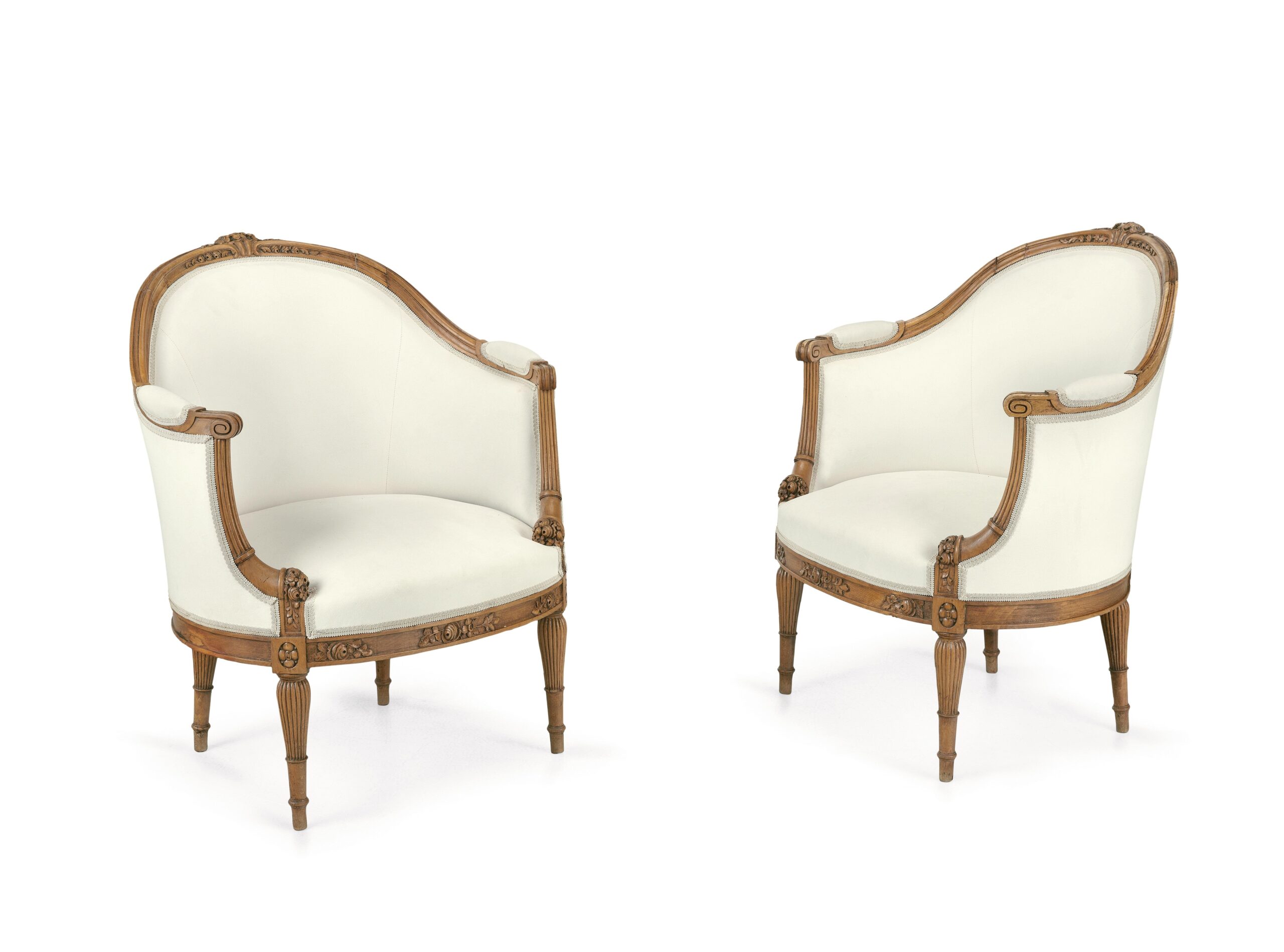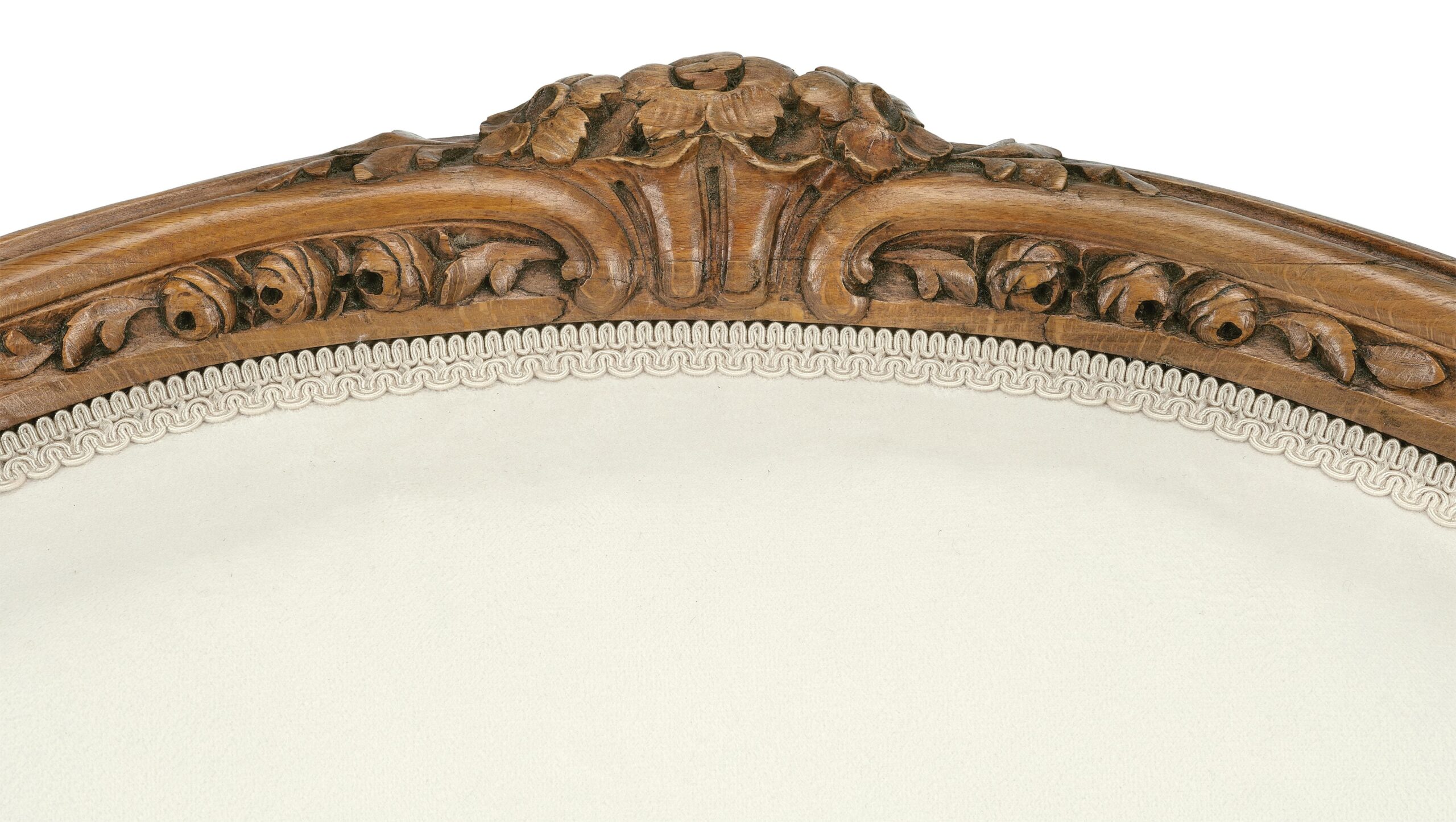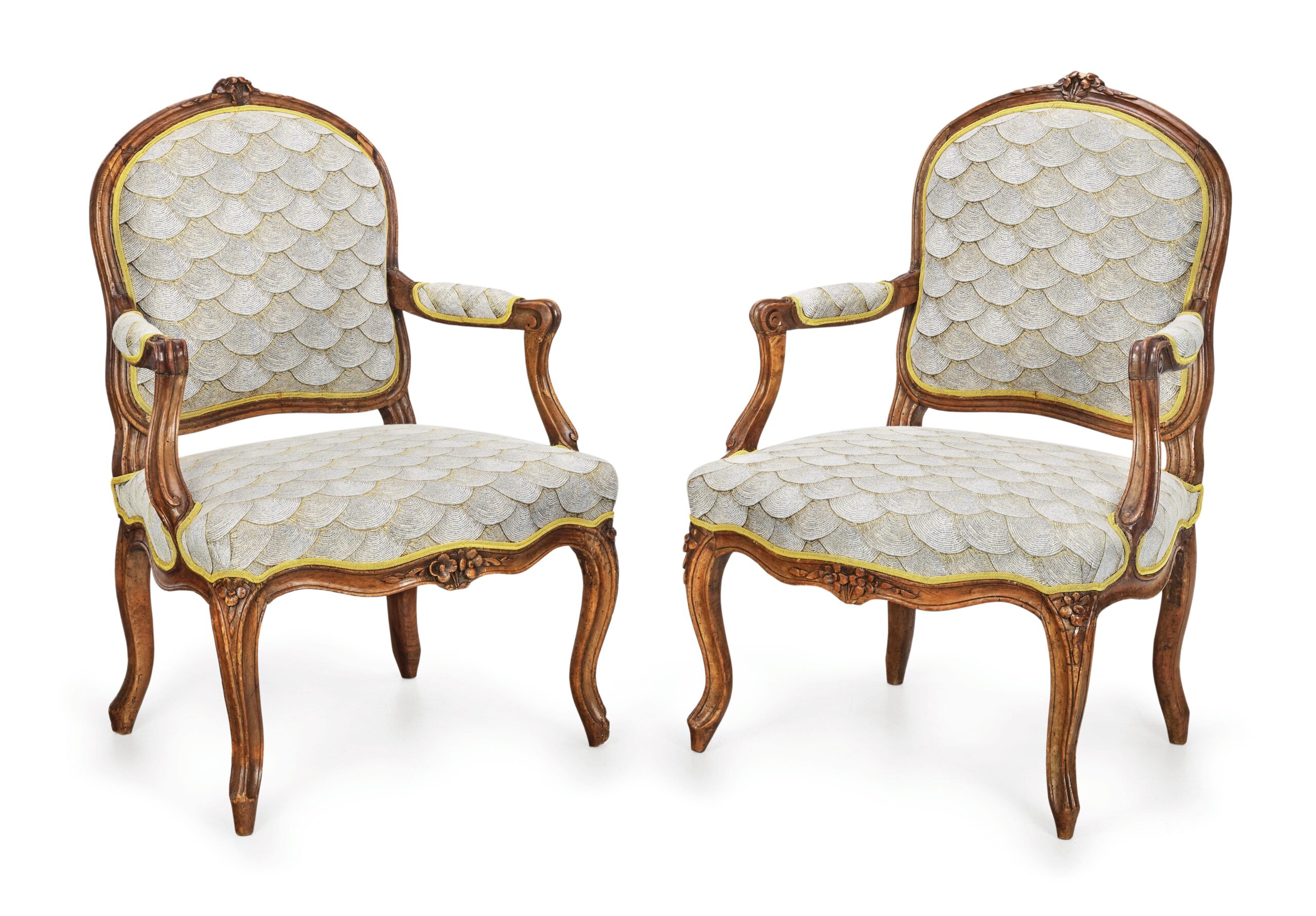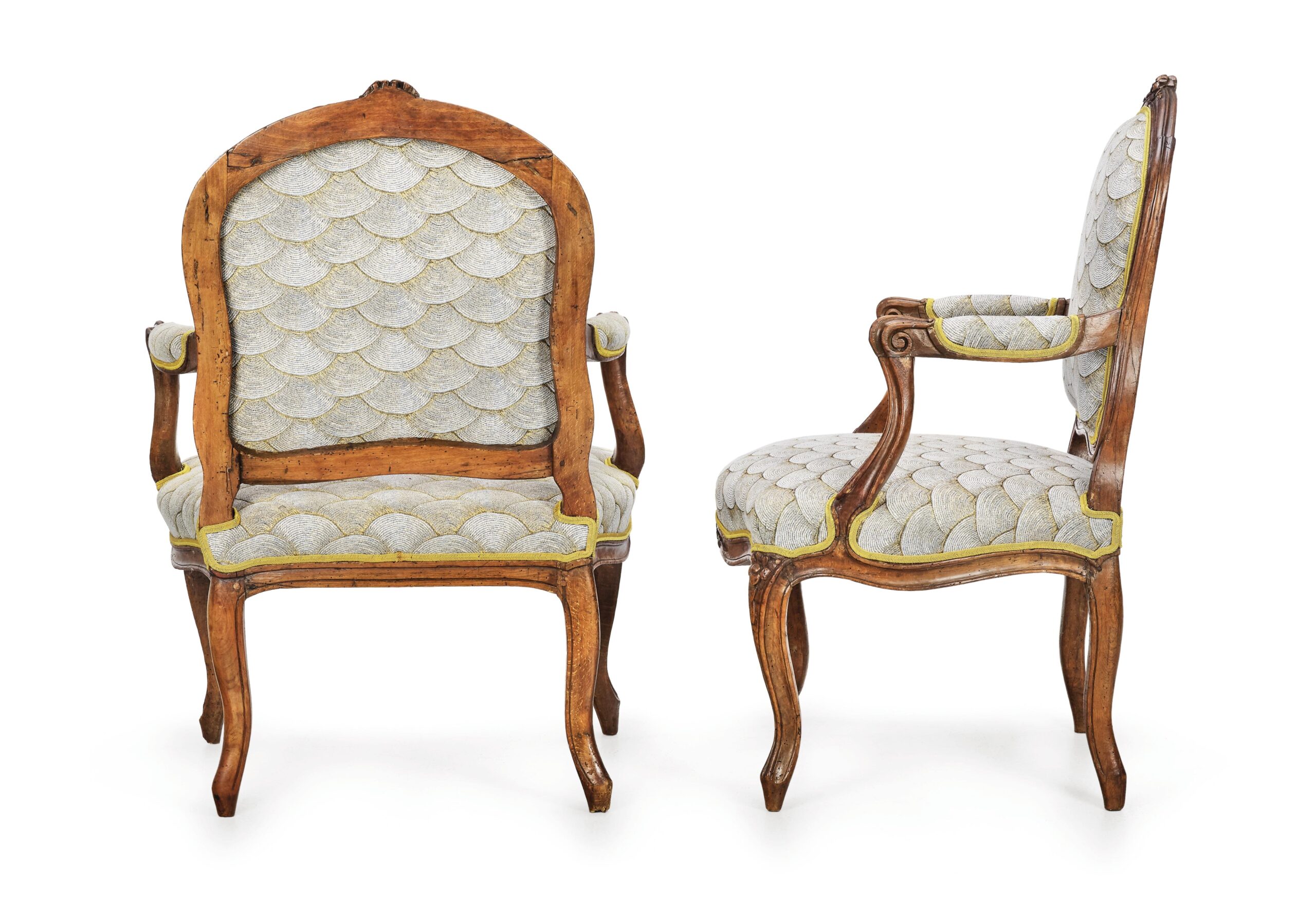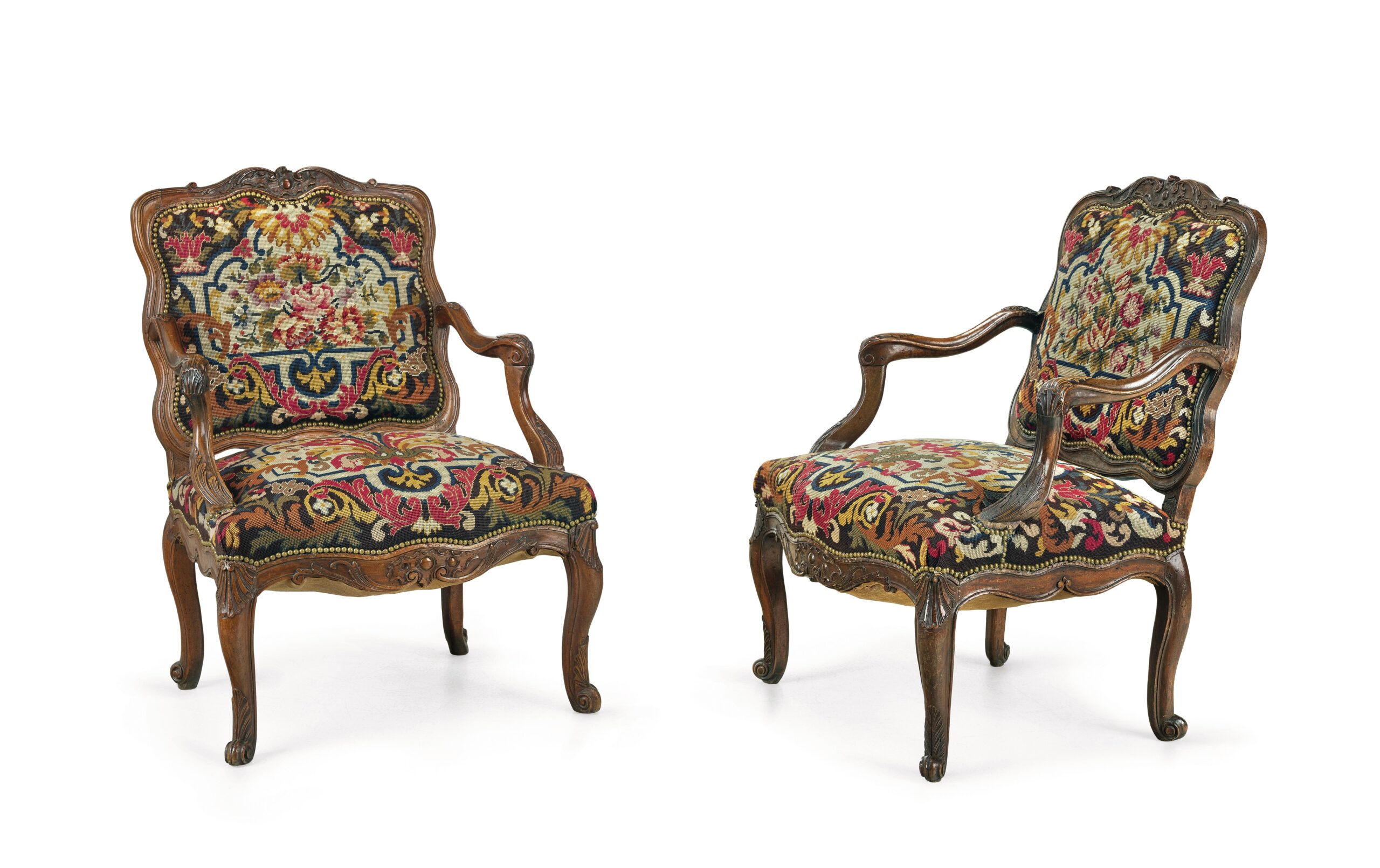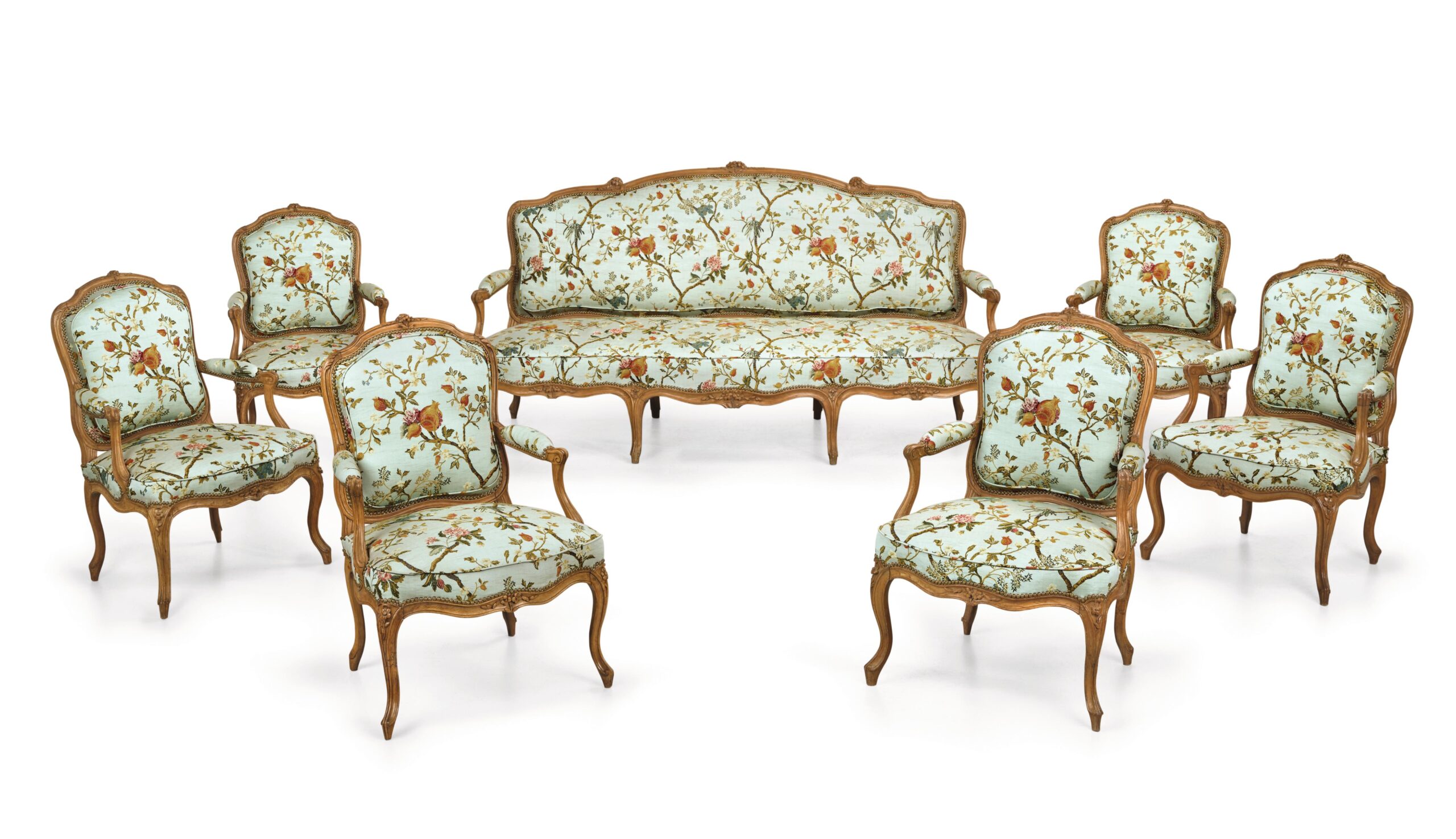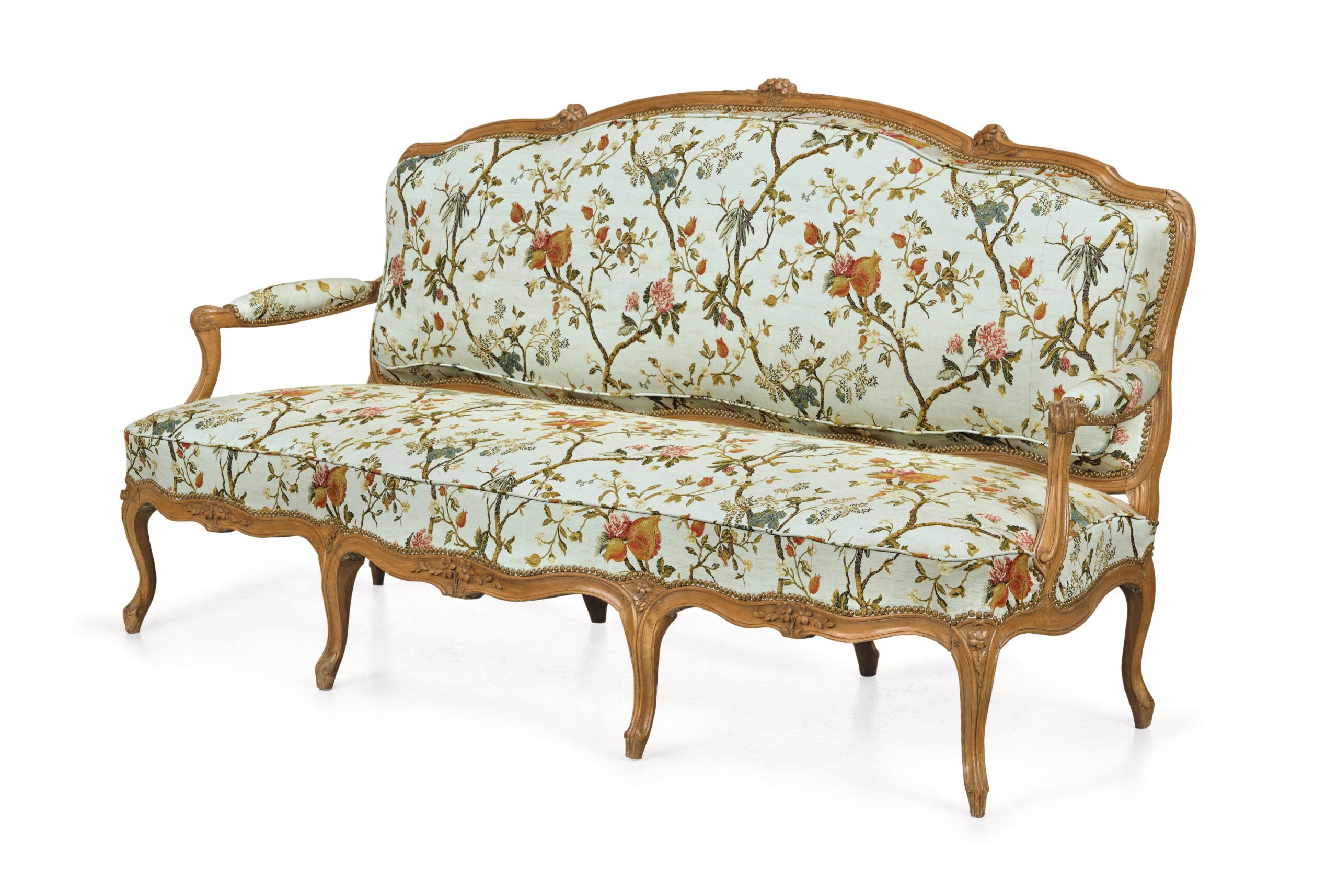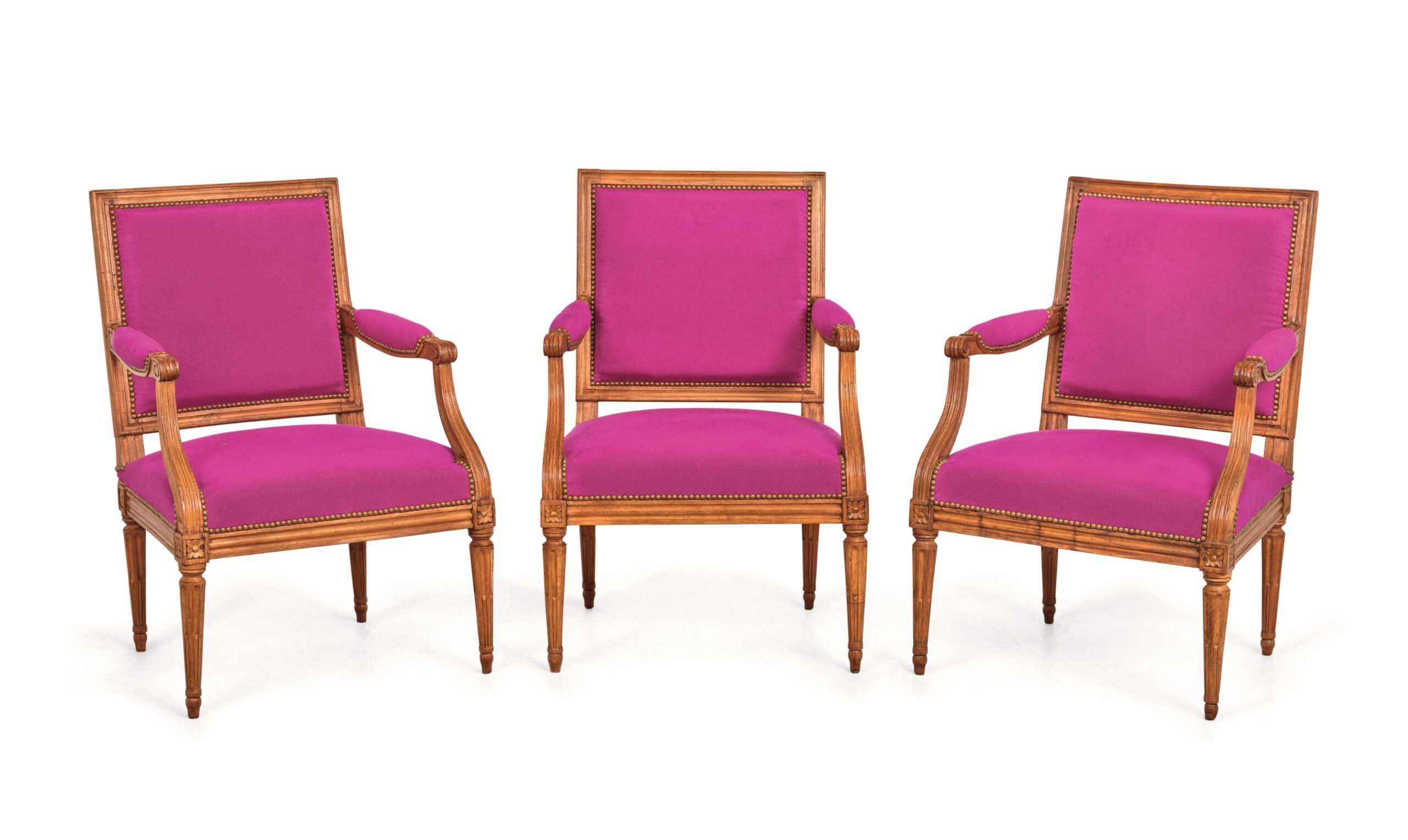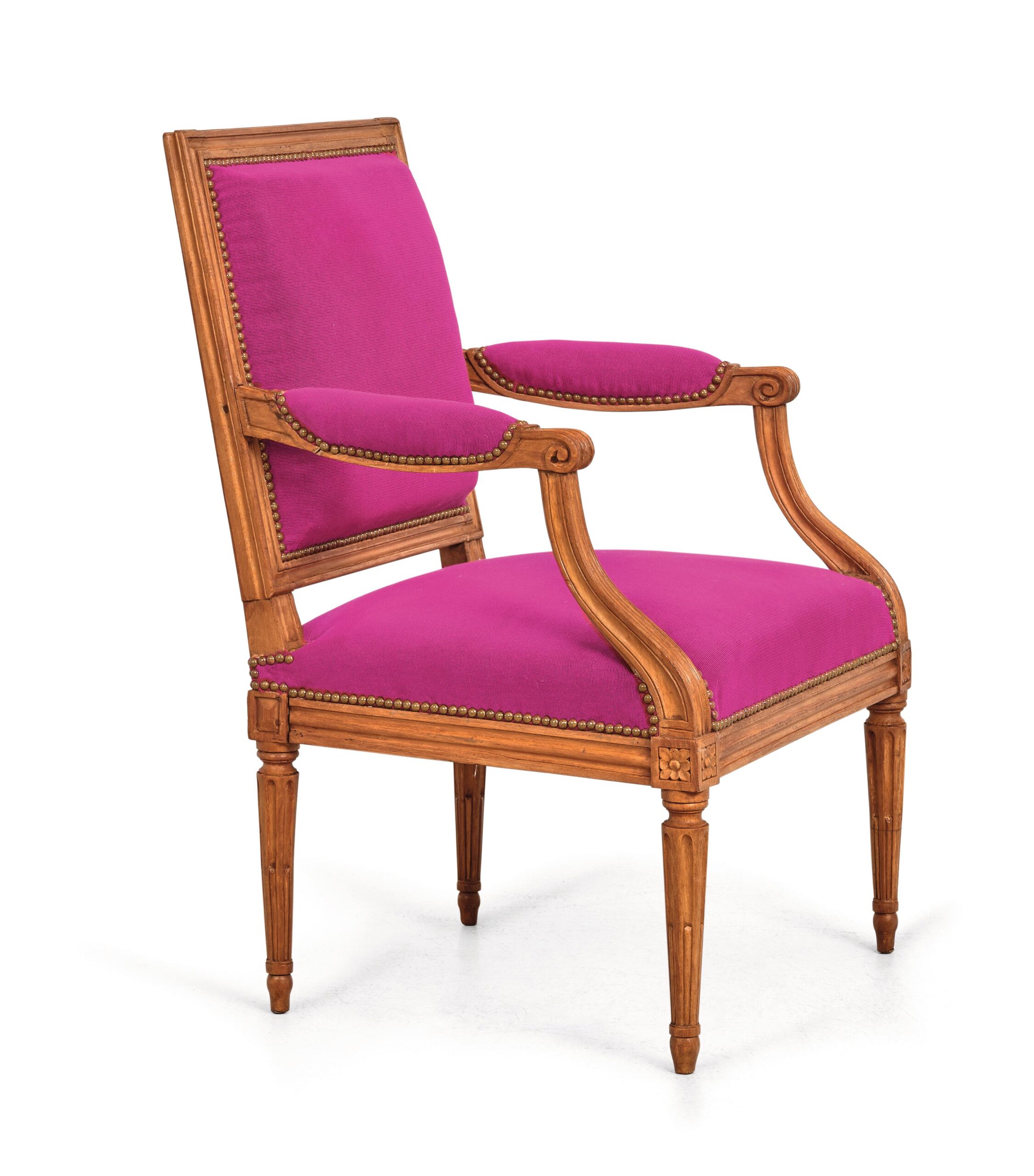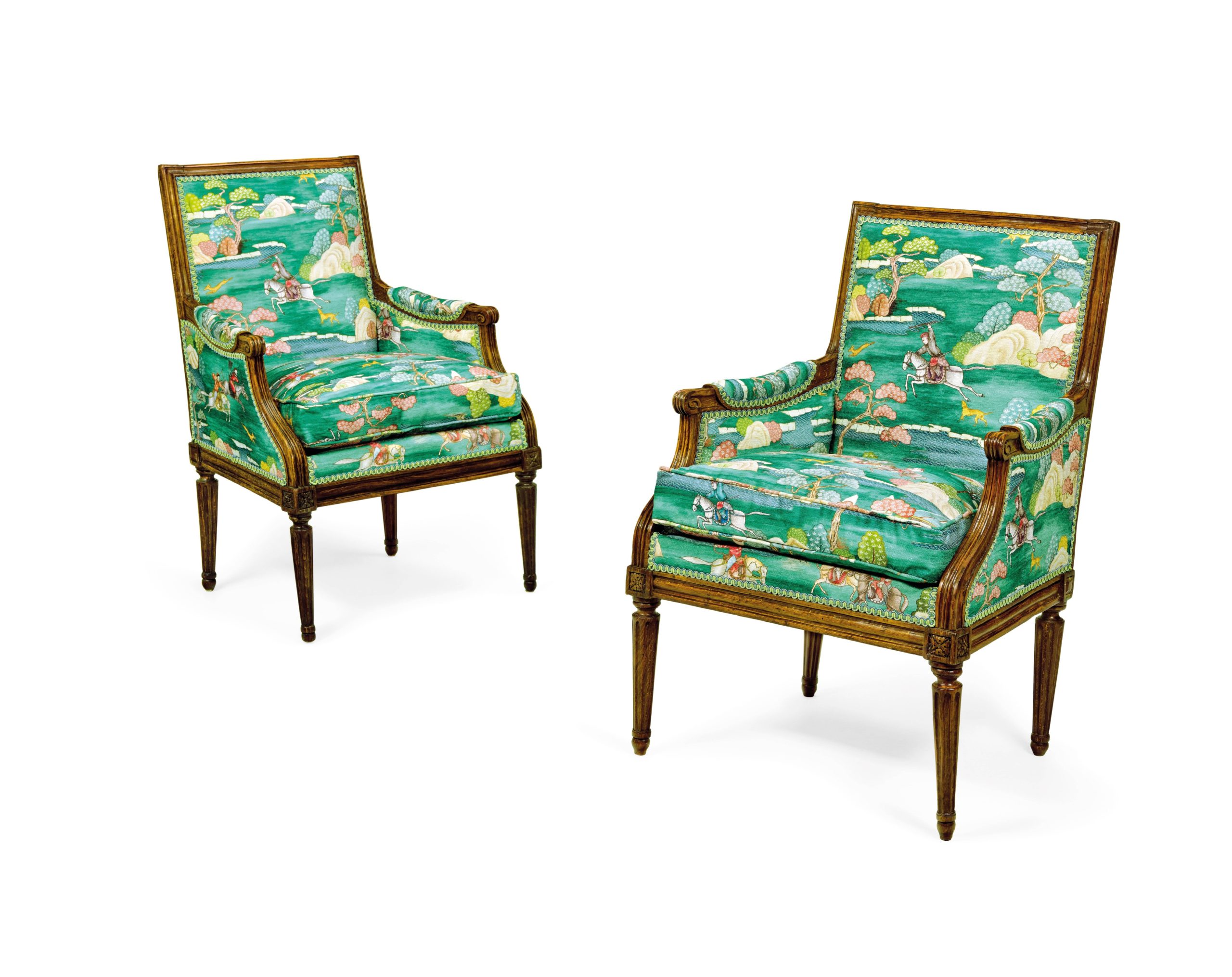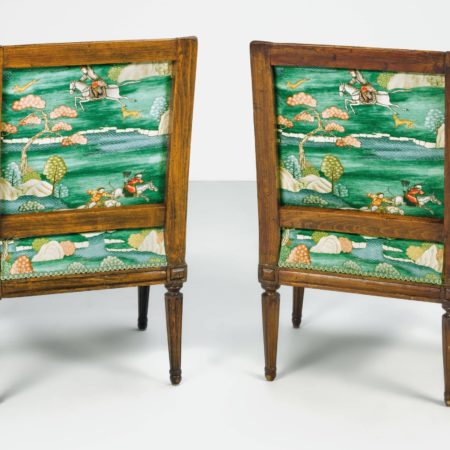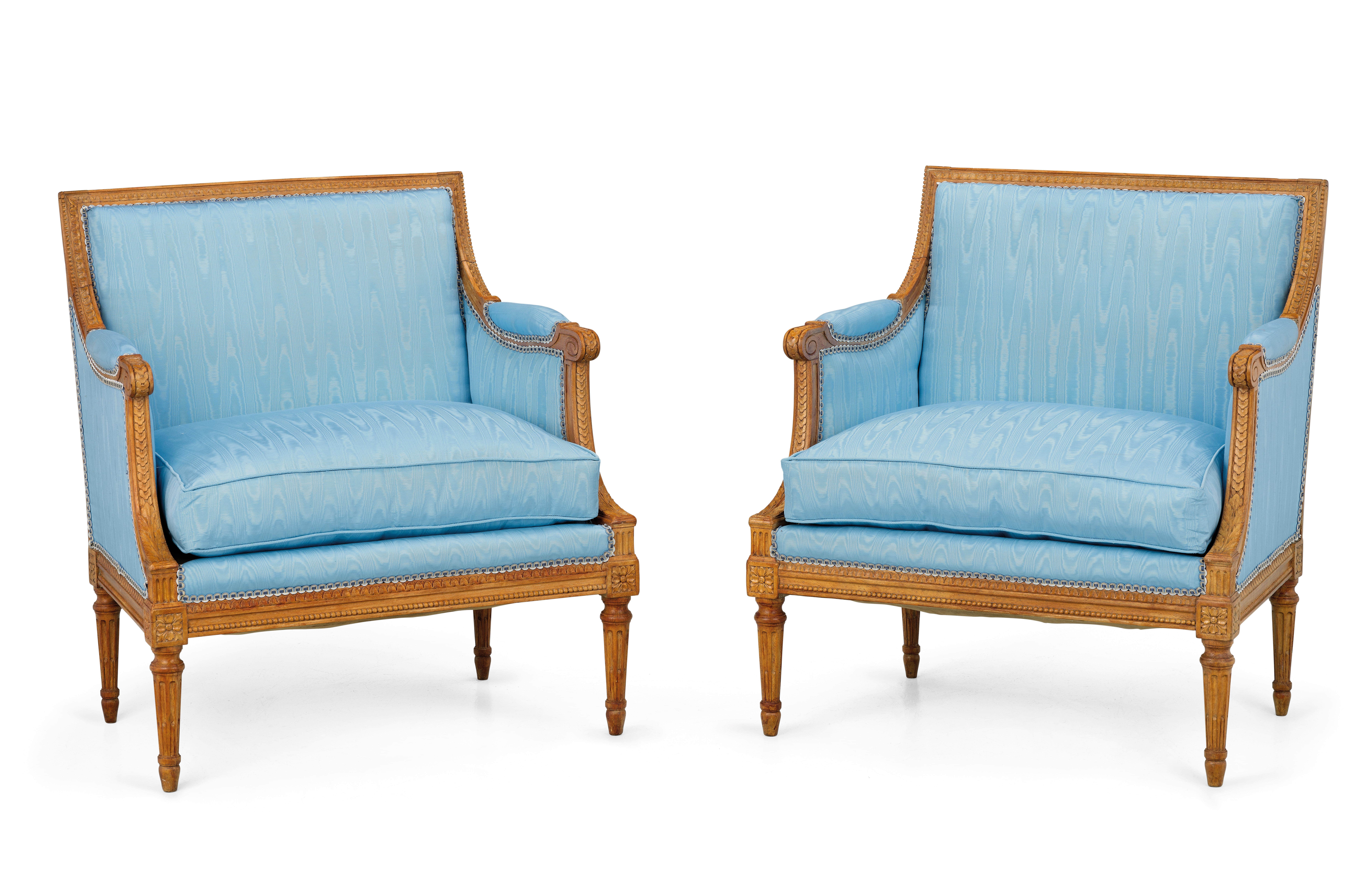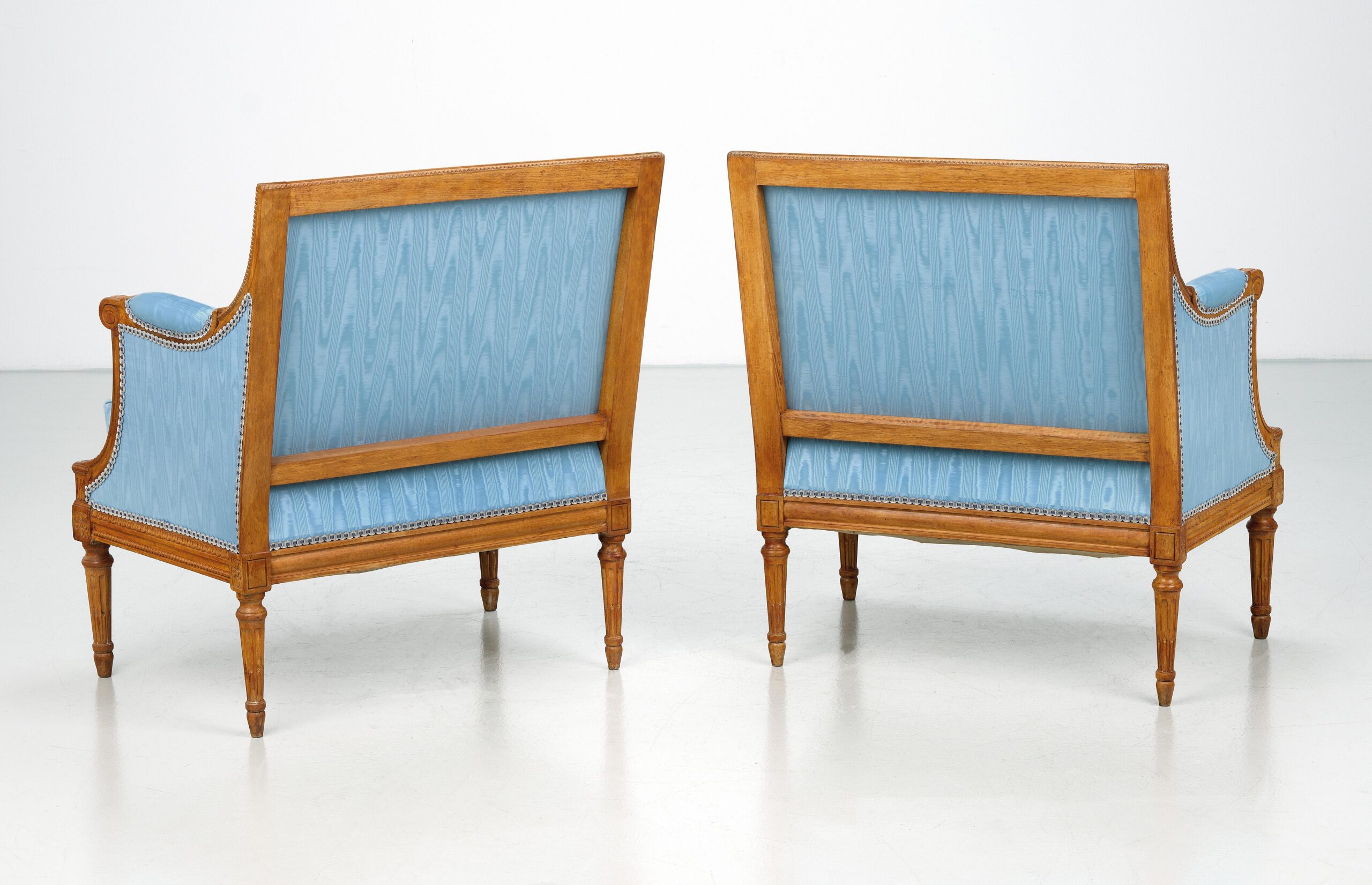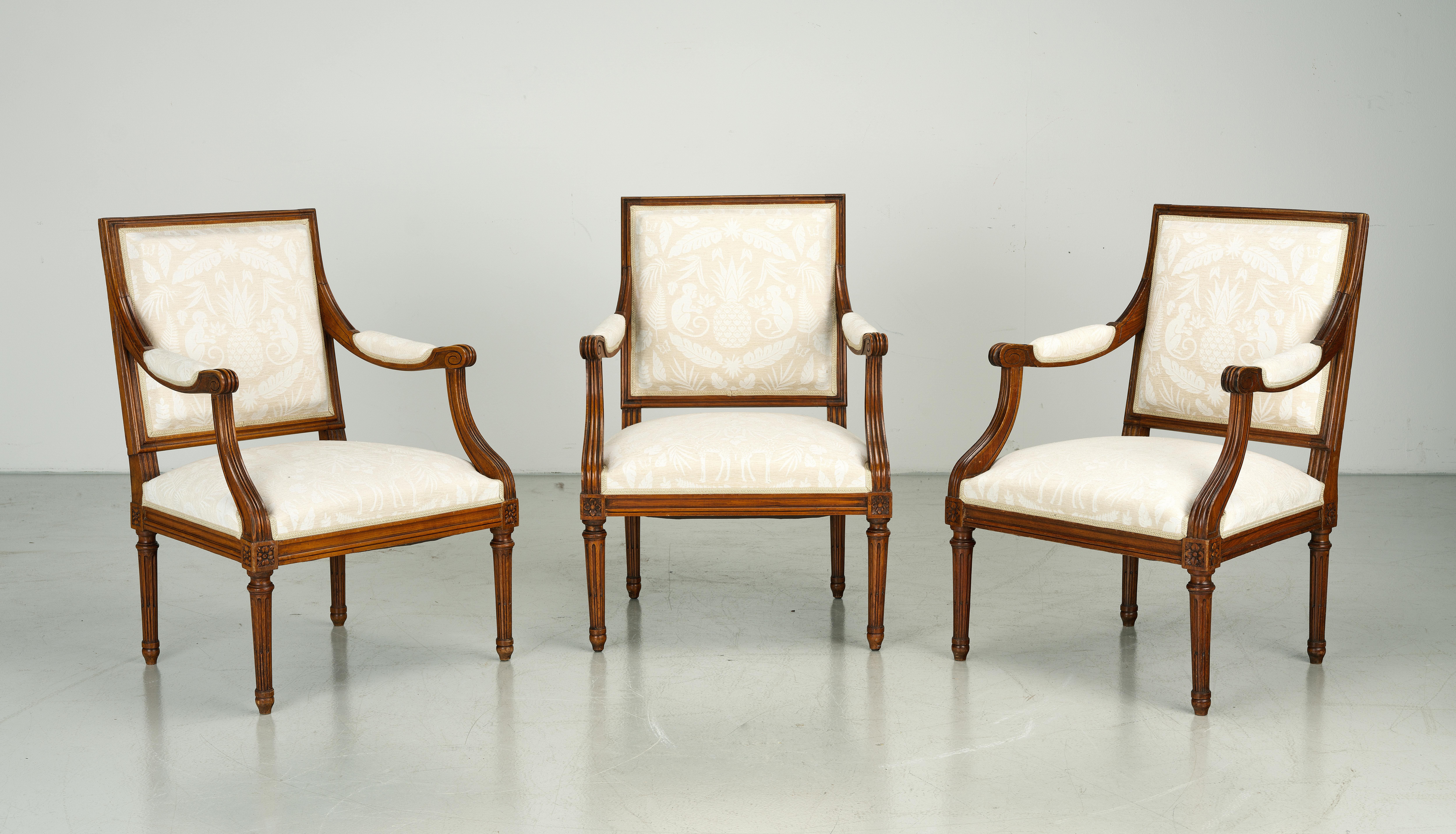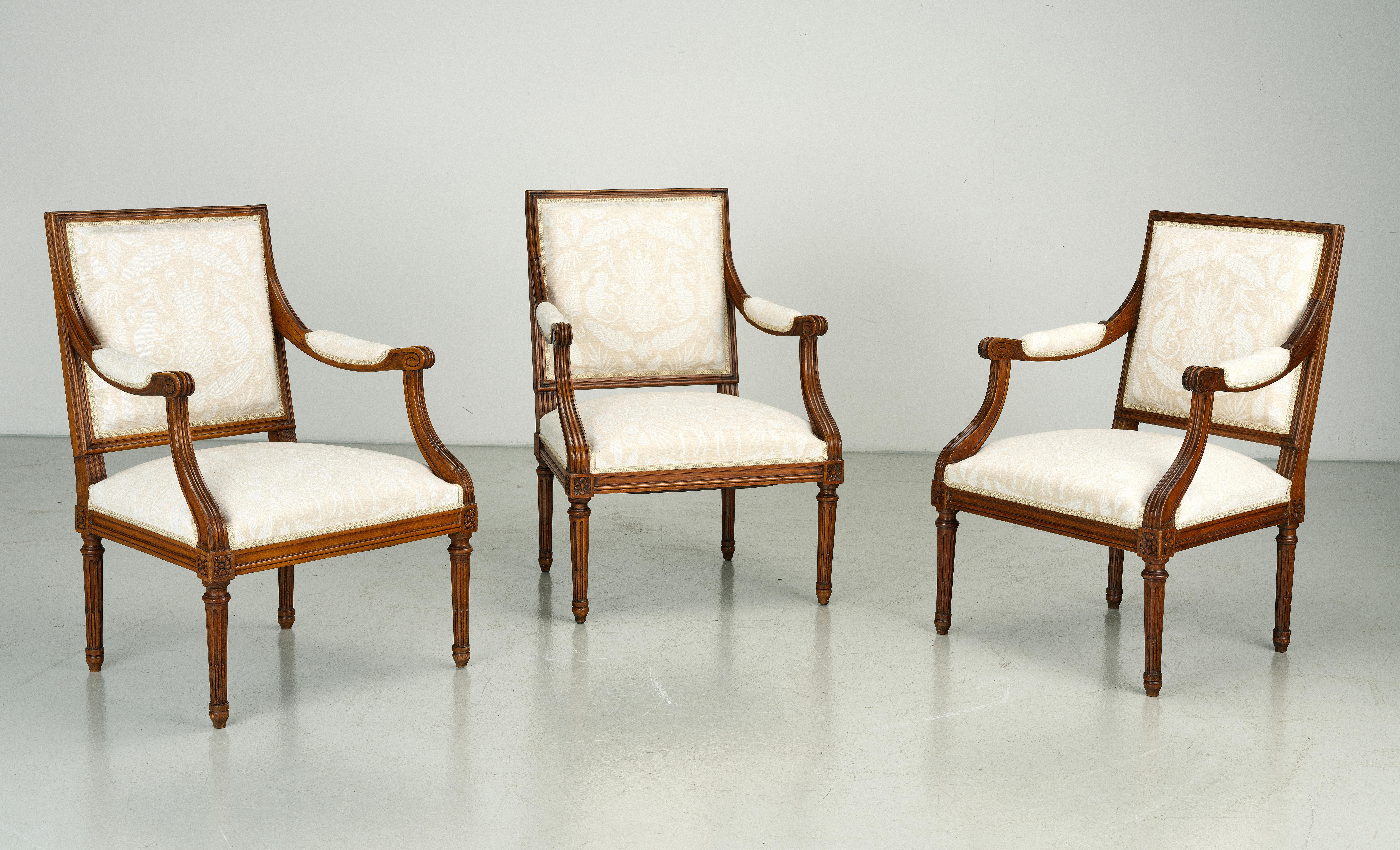Seating furniture

 €2,800.00
€2,800.00In Louis XV style, 19th century, curved beechwood frames, carved with ornamental motifs and in the form of stylised flowers and leaves, the back with chip carving décor, stained brown, matte finish, high-quality new upholstery, 97 x 74 x 65 cm, seat height 44 cm, beautiful restored condition.
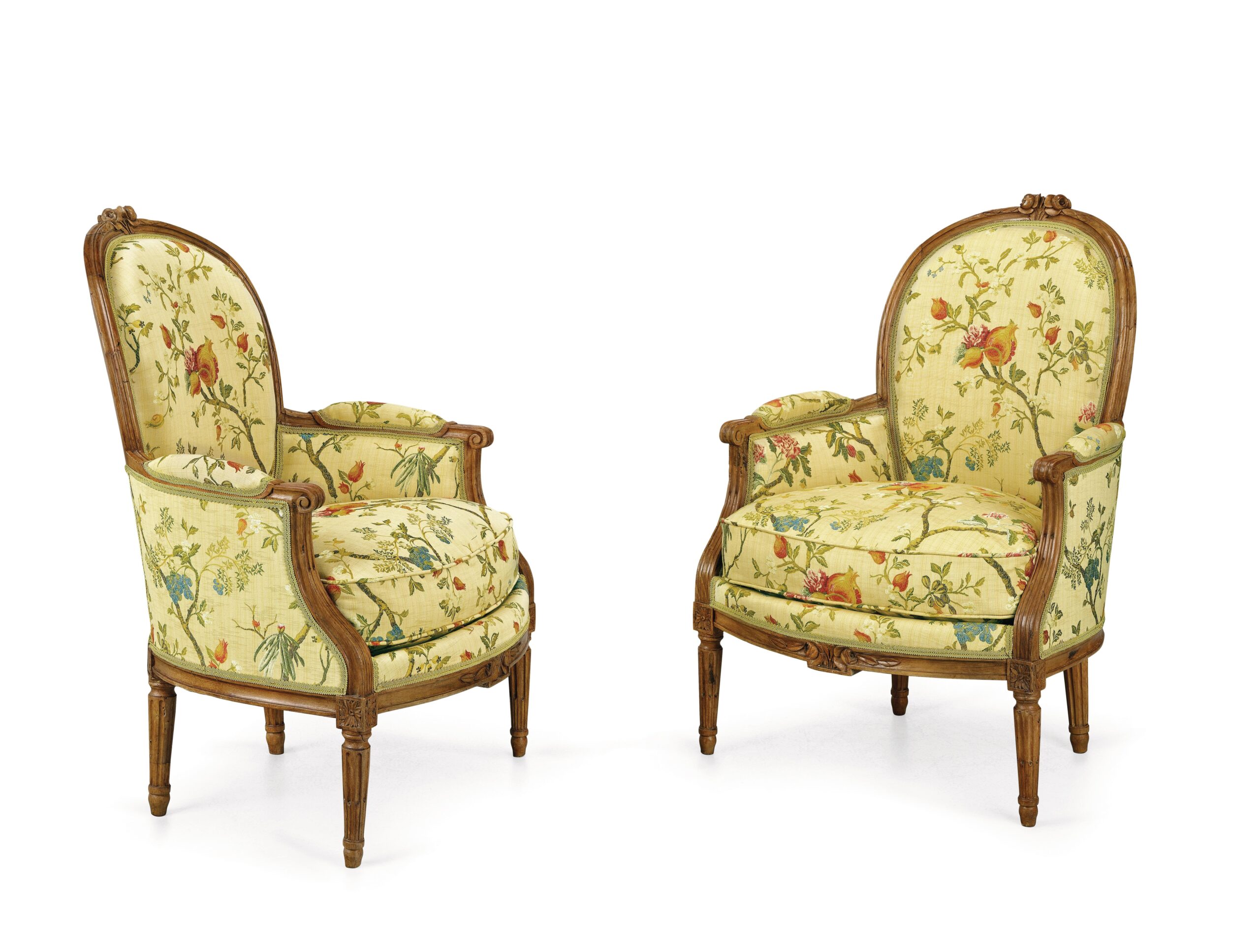
 Sold
SoldFrance, c. 1780, curved fluted walnut frames, backrest area florally carved in the shape of rose blossoms, matted, high-quality renewed upholstery, cover with Colony fabric pattern. Stamp J. I. ROUSSENS. F, (master from 1784), approx. 96 x 66 x 67 cm, seat height approx. 43 cm, beautiful restored condition.
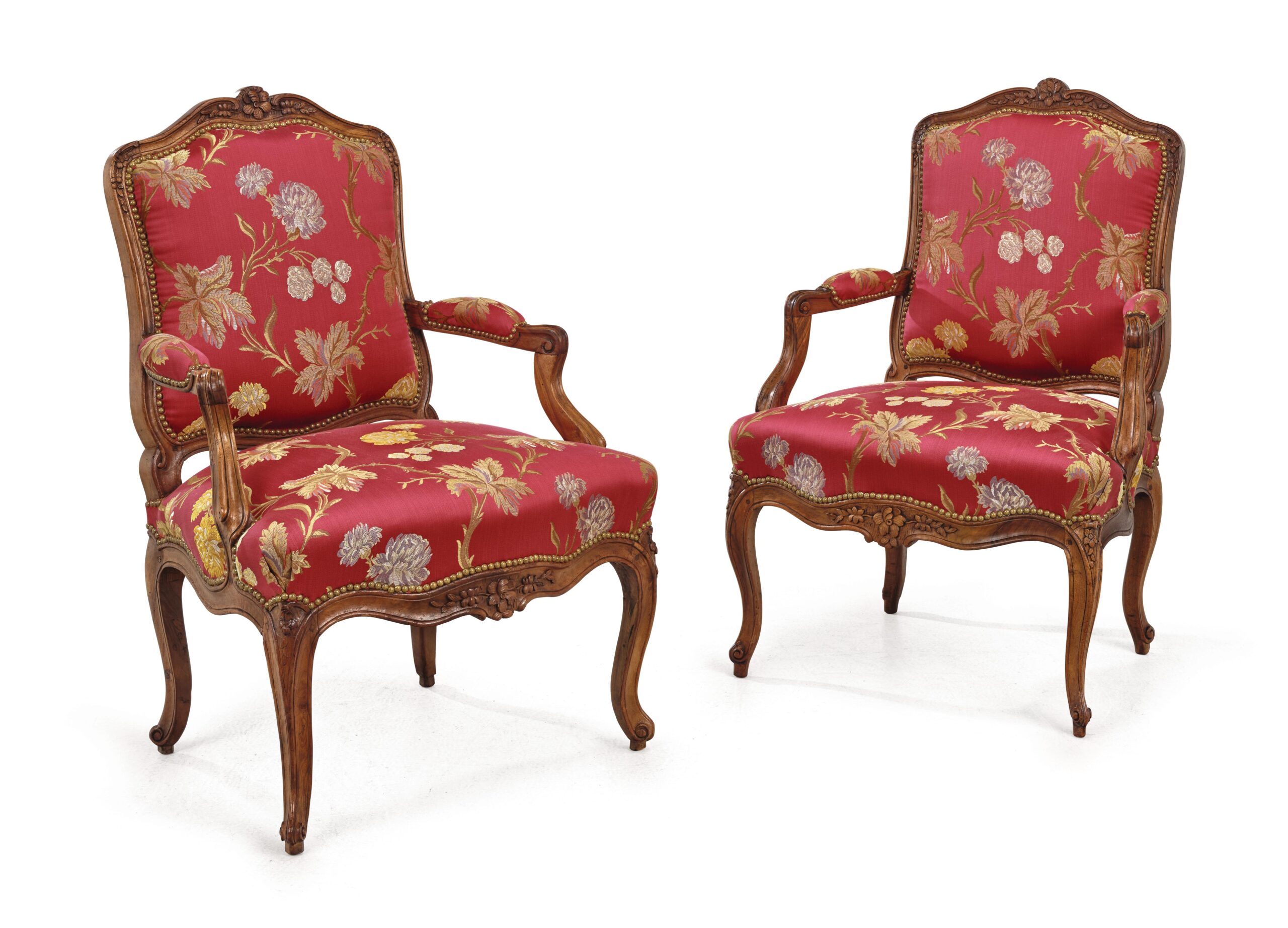
 Sold
SoldElegant French armchair from the Louis XV period, mid-18th century. The beautifully curved walnut frame is finely carved with stylized leaves and floral motifs, featuring a profiled and matte finish that highlights the graceful Rococo design. Newly upholstered with high-quality fabric, this restored piece is an excellent example of refined French craftsmanship.
 -28% OffOriginal price was: €5,000.00.€3,600.00Current price is: €3,600.00.
-28% OffOriginal price was: €5,000.00.€3,600.00Current price is: €3,600.00.Louis XV period, mid 18th century, curved beechwood frames, partly moulded and florally carved in the form of flowers and leaves, high-quality renewed seat, backrest and armrest upholstery, (imitation fish scale cover) 93 x 64 x 61 cm, seat height 42 cm, restored condition.
 Sold
SoldLouis XV period, by the French ebenist Louis Delanois, mid 18th century, consisting of: 6 armchairs and a large bench, (width 205 cm), curved, profiled and partially carved beechwood frames in the form of flowers and leaves, natural matt finish, stamped Delanois, (Louis Delanois, master from 1761), upholstery with colony fabric cover renewed in high-quality craftsmanship, beautiful, well-kept and restored general condition.
Along with Cresson, Foliot, Heurteau and Tilliard, Louis Delanois was one of the most important cabinetmakers of the Louis XV era. He received commissions from the Prince of Conde and the Duc d’Orleans, among others. Madame du Barry, Louis XV’s favorite, had him make all the seating furniture for the Château de Fontainebleau. His clients also included the court of Louis XV and Louis XVI, the court of the Polish King Stanislas II (later Duke of Lorraine) and Catherine the Great of Russia. His seating furniture is characterized by harmonious proportions, clear, elegant lines and perfect carving. His works can be found in the collections of the Louvre, Arts Decoratifs, Fontainebleau, Metropolitan Museum, among others.
 Sold
SoldBeautiful pair of bergeres from France. Era Louis XVI, around 1780. Profiled and partly fluted beech wood frames, stained brown an matted. The upholstery rebuilt with horsehair and covered with high quality fabric. Loose seat cushions, on the lower side of the frame stamped A. Mouzard, (Antoine Mouzard, master from 1755)
 Sold
Sold- Pair of wide armchairs, so-called Marquises.
- Marquises, product of the Soubrier company, Rue de Reuilly.
- Paris, early 20th century, beech wood frames of fine quality.
- Ornamentally carved as well as in the form of acanthus leaves and pearl bars, matted, partly fluted, wallpapered on the reverse, loose seat cushions, usable on both sides, company name on the underside.
- 82 x 74 x 60cm
- Seat height 43 cm
- Beautiful restored condition.
Antique Seating Furniture: A Legacy of Elegance and Comfort
Seating furniture has undergone a remarkable evolution over the centuries, blending stability, functionality, and aesthetics. Until the end of the 17th century, the primary focus was on durability, with chairs, stools, and benches designed to withstand significant weight. Stability was achieved by connecting the legs with sturdy crossbars, and hardwoods such as walnut and oak were predominantly used. Straight board legs were common, while intricately carved spiral and hand-turned designs were more rarely crafted.
The Transformation of Seating Furniture in the 18th and 19th Centuries
The 18th century marked a turning point when comfort became a priority in seating furniture design. Upholstery evolved from hay and wool fillings to more refined materials such as seaweed and horsehair, providing a resilient “feather effect.” The 19th century saw further advancements with the introduction of iron and steel springs, enhancing comfort and durability.
French Seating Furniture: Timeless Style and Craftsmanship
France played a pivotal role in the evolution of seating furniture. Curved legs first appeared during the reign of Louis XIV, setting the stage for the more fluid and ornate designs that characterized the Regence and Louis XV periods. These graceful forms became the hallmark of sophisticated interiors. Under Louis XVI, early classicism introduced straighter, more structured legs, a style that remained dominant until the revival of curved designs during the Louis Philippe era.
In addition to upholstered seating, woven cane seats and backrests (siège cané) were also popular, offering an elegant alternative. Whether upholstered or caned, antique seating furniture remains a testament to the exquisite craftsmanship of the period.
The Artisans Behind Antique Seating Furniture
The creation of seating furniture involved a collaborative effort among specialized craftsmen. While veneered furniture was the domain of ébénistes, seating pieces were the responsibility of menuisiers en sièges, expert chairmakers who primarily worked with beech, oak, or cherry wood. Once crafted, the pieces were passed on to tapestry makers for luxurious upholstery, with gilders occasionally adding decorative finishes.
Some of the most renowned menuisiers en sièges of the period include Foliot, Heurtault, and Cresson under Louis XV, and Jacob, Sené, and Boulard during the Louis XVI era. Many pieces produced by these masters were stamped with an embossed mark, a hallmark of Parisian craftsmanship that is highly sought after today.
Antique Seating Furniture: A Lasting Influence
The elegant designs of 18th-century French seating furniture were so influential that they were widely adopted by other countries, and replicas of these iconic models continue to be produced globally to this day. Whether as a functional piece in a modern home or as a collector’s item, antique seating furniture brings a touch of history and sophistication to any interior.
Explore Our Collection of Antique Seating Furniture
Discover our extensive collection of antique seating furniture, featuring exquisite craftsmanship and timeless designs. Browse our online store or visit our Vienna showroom to find the perfect piece that adds comfort and elegance to your home. From intricately carved chairs to beautifully upholstered armchairs, our collection offers a range of seating options that celebrate the artistry of bygone eras.


